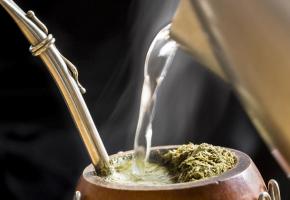“¿Probaste mate?”
I looked down at the rather oddly shaped wooden cup that had been thrusted into my hand. It contained – what appeared to be – a collection of grass cuttings and twigs that had been dampened and laid to rest. From them protruded a metal straw.
“¡Tomá!” she urged.
I did as I was told. I took a sip of the herbaceous concoction and immediately winced. Out of politeness, I took another.
“¿Te gustó?”
I wasn’t sure. I think I did. As an avid herbal tea drinker, it was not a taste that was entirely alien to me. Yet it was unlike anything I had tried before. It was only after a further four or five sips that I was able to determine whether the astringent bitterness was agreeable to me.
“¡Sí!”
So, the British have their tea, the Italians their coffee, the Argentines have their mate.
Be-it the first beverage of the day, or last at night; in the street, classroom, workplace, even in the gym, it is a beverage that is suitable for any situation, time of the day, and location. Whilst it can be enjoyed alone, is unquestionably better shared amongst others.
Arriving in Argentina as a twenty-something-year-old gringa, my opinion of this bizarre beverage became a hot topic of conversation, and it is not hard to understand why. Yerba mate is a South American staple. Labelled the national beverage of Argentina, and boasting a 92% consumption rate in Argentine households, it is a fundamental element of Argentine life. Subsequently, do not be alarmed to see Argentines (and Uruguayans even more so) ambling down the street carrying their mate in one hand and termo (thermos flask) in the other. Strange, I know.

So how does it work?
Mate is drunk through a metal straw (la bombilla) from a hollow gourd. The size and shape of the gourd itself can vary, however, it is generally about the size of an apple, and is traditionally made from a hollowed calabash – a product which many still believe produces the best tasting mate. Today it is common to find gourds made of various materials including wood, glass, ceramic, and even silicone.
Filled with a bitter herb called (yerba mate) and hot water, the perforated end of the straw allows liquid to pass through it in the form of a drink. To confuse matters, one should note that mate is both the drink itself, as well as the gourd from which it is drunk. The yerba is the herb placed inside and is grown in the warm and fertile northern provinces of Corrientes and Misiones. Currently Argentina is the largest producer of yerba mate in the world whose blend consists of a mixture of leaves, steams, and powder (palo). The plant itself is a species of holly that can grow up to 15 metres. High in antioxidants and nutrients, its health benefits are vast, and in some parts of South America it is known as, ‘The Drink of the Gods.’
Naturally, everyone will have their own customs when it comes to sharing mate. Much like Whiskey, there is a wide variety of different types of yerba, each of varying cuts, grades, tastes, textures, and bodies, depending upon the region it is sourced from. Subsequently, each will embody distinct tastes, flavours, and aromas. Heavens! With entire supermarket isles dedicated to the stuff, it can be quite mindboggling when it comes to choosing the right blend. Filled with different notes and nuances, yerba mate can be incredibly versatile. Whether opting for the mellower flavours of Taragui, the smoky undertones of Cruz De Malta, or the striking harmonisation of citrus and woody notes of Rosamonte, mate can be prepared to suit all pallets.

There are, however, are a few ground rules that are important to bear in mind in order to enjoy a truly authentic matecito.
1. When it comes to drinking mate, there will always be one server (el cebador). Traditionally this task would fall upon the youngest present whose job it would be to serve mate to his elders.
2. The server must begin by heating the water in a kettle (pava) to an optimal temperature of around 82C °. Serve it too hot, you will burn the yerba (and your tongue); serve it too cold and the yerba is not ‘awakened.’
3. The server will then fill the gourd with an appropriate portion of yerba, cover the top with their hand and shake it to get rid of any dust. Tilting the gourd at a slight angle until the yerba covers the side and almost reaches the top, hot water is then poured into the bottom of the cavity and let stand for a few seconds allowing the mate to gradually release its components. One could liken this to the ‘breathing process’ of a young red wine.
4. After a few minutes, the filtered end of the bombilla is placed into the wet area and laid against one side of the gourd. Once the water is adequately heated, it may be put in a thermos flask to keep warm.
5. Whilst avoiding wetting the upper part of the yerba too much, the server will pour himself the first serving to ensure it is suitable for consumption.
6. The mate is then passed from person to person. Each person drinks the entire contents and passes it back to the server who will refill it and pass it on.
¡Ojo! The first sips tend to be the most bitter, and some servers may place a spoonful of sugar or honey in the mate to curb the bitterness and sweeten the yerba. This comes down to personal preference. However, it does mean that you will most likely be asked whether you enjoy your mate amargo (bitter) or dulce (sweet). One may also be inclined to add a little mint, chamomile, or even orange peel to the yerba. Despite traditionally served hot, during the soaring South American summers, it may also be served cold. This infusion of yerba mate prepared with cold water or juices is called Tereré.
 (right) my cat and my mate (left) mate-pouring contraption my friend installed in his car
(right) my cat and my mate (left) mate-pouring contraption my friend installed in his car
Still with me? Almost there. Just a few more things to be aware of and you will be well on your way to serving mate like a pro.
The dos and don’ts of an authentic mate experience:
DO NOT say gracias (thank you) when handing back the mate unless you have had enough. Although it may come naturally, doing so signals to the server that you do not want anymore.
DO change the yerba. After several rounds, the yerba tends to get diluted, or lavado (washed) and it will be necessary to change either a portion or all of the yerba.
DO be attentive when serving. Serving mate is a big responsibility and it is important that the server is attentive to the quality as well as the continuity of the service.
DO NOT hog the mate for too long. If the server becomes slacking in his duties or engrossed in conversation, one may sharply be reminded that, ‘¡no es un micrófono!’ Equally, if an individual in the group takes too long drinking their share whilst pontificating about this or that, people may become impatient and encourage him to pass it back to the server.
DO respect the mate. It is a ritual that is steeped in history and tradition. The history of yerba mate is vast and can be traced back to the semi-nomadic Guarani people of southern Brazil, northern Argentina and Paraguay who first harvested the leaves and twigs of this evergreen shrub. Using it as a daily tonic, natural stimulant, and even as currency when trading with the Incas and Churruas, it was later discovered by Spanish conquistadors, and became a staple in the gaucho diet. Today it is enjoyed by all, and continues to form an integral part of Argentine culture.
DO NOT get surprised if you find yourself craving the stuff. After all, what else has the strength of a Lavazza coffee, the rejuvenating health qualities of Green Tea, and the appeal of Lindt chocolate?
DO enjoy the experience. It is precisely the ritual of congregating with friends over a few rounds of mate that encapsulates everything I love about this fascinating and chaotic country: friendship, sharing, togetherness. In short, the Argentine population itself.
Trying mate for the first time is an experience one could liken to your first taste of blue cheese: upon your first mouthful, you may not be enamoured. Perhaps you are almost a little repulsed. However, after a little persistence, you soon grow quite fond of it, and after a while, will wonder how you ever survived without



















